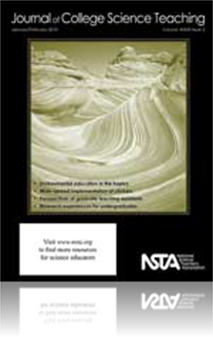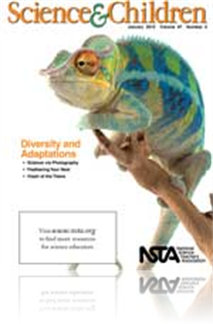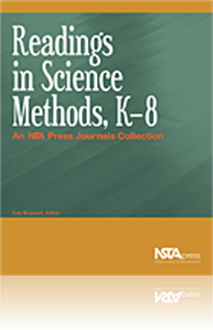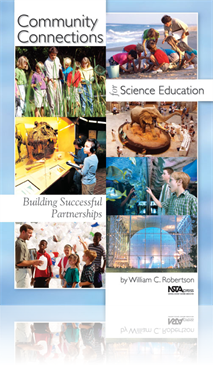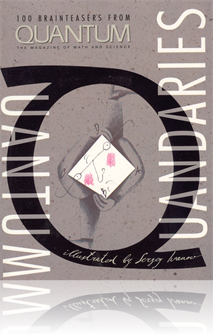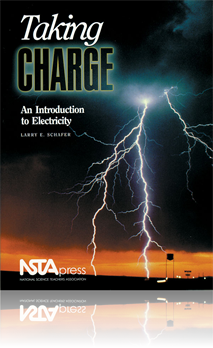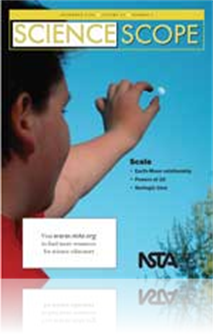All Resources
Journal Article
Science 2.0: Introducing Science 2.0!
The internet of the mid-to-late 1990s was defined by static web pages created by people with specialized technical skills. Today, that barrier has been all but eliminated with the emergence of easy-to-use online tools for creating and sharing content...
Journal Article
Gel Electrophoresis on a Budget to Dye For
Gel electrophoresis is one of the most important tools used in molecular biology and has facilitated the entire field of genetic engineering by enabling the separation of nucleic acids and proteins. However, commercial electrophoresis kits can cost u...
Journal Article
Students are scientifically literate when they can read material about science and intelligently communicate their viewpoints, comments, and critiques, using scientific vocabulary and applying the ideas of the process and nature of science. As part o...
Journal Article
Methods and Strategies: Inventive Learning Stations
Learning stations can be used for myriad purposes—to teach concepts, integrate subject matter, build interest, and allow for inquiry—the possibilities are limited only by the imagination of the teacher and the supplies available. In this article,...
Journal Article
What should I know about mercury levels in fish? And are there any recommendations for the types and amount of fish I should eat?...
Journal Article
Science 101: What’s behind the biological classification system in use today?
Whether students should memorize classification schemes (taxonomies) is a column in itself, but the author can address the role that this system plays in the study of biology. To that end, it will help to address how the system developed over time. A...
Journal Article
Building Acceptance for Pedagogical Reform Through Wide-Scale Implementation of Clickers
Many instructional strategies exist that address poor student success in the sciences. They often go untapped, however, due to the knowledge or time needed for implementation. This article presents a formula for success that has encouraged a signific...
Journal Article
How to Make a Plant Field Guide
Every year, an elementary school celebrates different aspects of Central Texas ecology. This year, they focused on Blackland Prairie, the ecoregion on which the school is located. A schoolwide event at the end of the year offers students the opportu...
Journal Article
Writing-to-learn activities are designed to use writing as a process in which students generate and clarify understanding of scientific concepts for themselves, rather than simply communicating with a teacher for evaluation. Instead of having student...
Journal Article
Field-note poetry is the product of the authors’ efforts to combine current research in learning and cognition with integrated geoscience and language arts activities. In this article, they present a fun and effective activity that teaches students...
Journal Article
The Early Years: If You Were a Dinosaur…
Dinosaurs are one of those science topics that draw children in and teach them about concepts like measuring and using descriptive language. Learning about dinosaurs, although not hands-on like observing and recording caterpillar growth, develops cri...
Journal Article
Worms in the College Classroom: More Than Just a Composting Demonstration
Although worm bins have been used by K–12 and nonformal educators for decades, there is little evidence of their use in postsecondary education. The ease of use, maintenance, affordability, portability, and diversity of scientific concepts that can...
Journal Article
CSI: The Experience, a traveling museum exhibit and a companion web adventure, was created through a grant from the National Science Foundation as a potential model for informal learning. The website was designed to enrich and complement the exhibit ...
Journal Article
Editor’s Note: Approaching Adaptation
As students approach adaptations lessons, keep in mind that according to research, most lower-elementary school students are still forming a basic understanding of how animals survive in their environments. For example, many students understand a sim...
Journal Article
Children are naturally curious about the world in which they live. To focus this sense of wonder, have your students investigate their local habitat as it changes over the year. This multiseason study will build connections and add relevance to the h...
eBook
The Big Ideas of Nanoscale Science and Engineering: A Guidebook for Secondary Teachers (e-book)
Given the ability of nanoscience and nanotechnology to exploit the unique properties that matter exhibits at the nanoscale, the research resulting from these emerging fields is poised to dramatically affect everyday life....
eBook
Readings in Science Methods, K–8 (e-book)
If you’re teaching an introductory science education course in a college or university, Readings in Science Methods, K–8, with its blend of theory, research, and examples of best practices, can serve as your only text, your primary text, or a sup...
eBook
Celebrating Cultural Diversity: Science Learning for All (e-book)
Science Learning for All: Celebrating Cultural Diversity covers three must-know” areas of multicultural science education: inclusive curriculum design, multicultural teaching strategies, and language diversity in science teaching and learning. Wit...
eBook
Building Successful Partnerships: Community Connections for Science Education (e-book)
No single educator can help children learn all they need to become scientifically literate. Resources are all around us—not only in traditional science classrooms and laboratories, but also in gardens, nature centers, parks, youth programs, museums...
eBook
Practicing Science: The Investigative Approach in College Science Teaching (e-book)
In this collection of ten articles reprinted from the Journal of College Science Teaching, college and university science professors show how they have used investigative learning—or inquiry-based instruction—to introduce students to the proce...
eBook
For extra credit or just for the fun of it—why not try a brainteaser? This collection brings together the first 100 brainteasers from Quantum magazine, published by the National Science Teachers Association in collaboration with the Russian magazin...
eBook
Taking Charge: An Introduction to Electricity (e-book)
Spark your students’ interest in electricity. Taking Charge is designed to help teachers bring the intimidating subject of electricity to students in the middle grades. These teacher-tested, hands-on activities use readily available materials and...
Journal Article
In “The Magic Mirror” lessons described here, children explore reflection and mirror phenomena in the environment. They make a mirror, explore a hinged mirror with its many images, and look at symmetries. The activities create great interest amon...
Journal Article
Teaching Through Trade Books: Flick a Switch
When students flick on lights, boot up a computer, or turn on a television, do they think about how that energy is produced? The majority of electricity in the United States is generated from power plants that burn fossil fuels, causing large amounts...
Journal Article
Scope on Safety: Beware of students bearing kits
After the holidays, many students are eager to bring in cool science-related gifts to share with their classmates. Items like laser pointers, introductory chemistry sets, rocketry kits, electronics/electricity kits, and microscopes to name a few, mus...
Journal Article
The Prepared Practitioner: Central Limit Theorem
Statistics have been an important part of science since Gregor Mendel used pea plants to study heredity in the 19th century, if not before. Everyday life is filled with statistics—about sports, the stock market, weather, and so on. Understanding ru...
Journal Article
Science Sampler: Walking Out Graphs
In the Walking Out Graphs Lesson described here, students experience several types of representations used to describe motion, including words, sentences, equations, graphs, data tables, and actions. The most important theme of this lesson is that st...
Journal Article
The Pennies-as-Electrons Analogy
Everyday experiences familiarize students with the ways in which electricity is used, but often the underlying concepts remain a mystery. Teachers often use analogies to help students relate the flow of electrons to other common systems, but many tim...
Journal Article
Visualizing the Earth and Moon Relationship via Scaled Drawings
Students’ difficulties with accurately conceptualizing the relationships among the Earth, Moon, and Sun are well documented. Any teacher who has seen the film A Private Universe (Schneps and Sadler 1988) will remember the challenge the interviewees...




